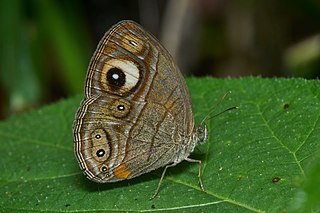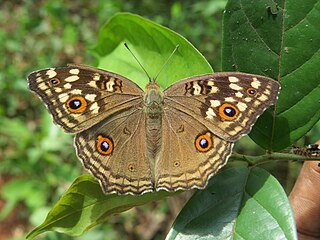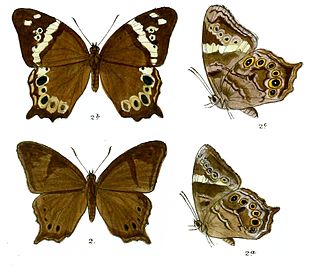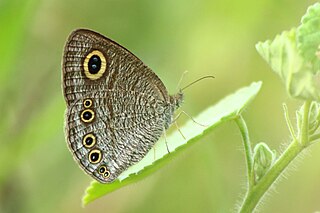
Mycalesis patnia, the glad-eye bushbrown, is a satyrid butterfly found in southern India and Sri Lanka.

Mycalesis oculus, the red-disc bushbrown, is a satyrine butterfly found in southern India. It is similar in markings to Mycalesis adolphei but distinguished by the reddish band around the large apical spots on the upper forewings.

Junonia lemonias, the lemon pansy, is a common nymphalid butterfly found in Cambodia and South Asia. It is found in gardens, fallow land, and open wooded areas.

Mycalesis, the bushbrowns, are a genus of brush-footed butterflies. They are common in the warm regions from Central Asia to Australia, and have a high diversity in South Asia and the Wallacea.
Mycalesis igilia, the small long-brand bushbrown, is a species of satyrid butterfly found in south India.

Orsotriaena medus is a butterfly found in south Asia, southeast Asia, and Australia. It is the only species in the genus Orsotriaena, first described by Hans Daniel Johan Wallengren in 1858.

Mycalesis terminus, the orange bushbrown, is a species of butterfly in the family Nymphalidae. It is found in Indonesia, New Guinea and Australia (Queensland).
Mycalesis anapita, the tawny bush-brown, is a species of Satyrinae butterfly described by Frederic Moore in 1858. It is found in southern Burma, southern Thailand, Peninsular Malaysia, Sumatra and Borneo.

Lethe daretis, the Sri Lanka treebrown, is a butterfly in the family Nymphalidae. It is endemic and restricted to cloud forests of central highlands of Sri Lanka such as Horton Plains.

Lethe dynsate, the Ceylon forester, is a butterfly in the family Nymphalidae. It is endemic to Sri Lanka.
Nacaduba ollyetti, the Woodhouse's four-line blue, is a species of Lycaenidae butterfly. It is endemic to Sri Lanka.

Nacaduba sinhala, the Pale Ceylon line blue, or Ceylon six-lineblue, is a species of Lycaenidae butterfly. It is endemic to Western Ghats complex.

Ypthima singala, the jewel four-ring or Sinhalese five-ring, is a species of Satyrinae butterfly. It is endemic to Sri Lanka and south India.

Heteropsis davisoni, the Palni bushbrown, is a species of satyrine butterfly found in southern India. Some authors consider this as a subspecies of Heteropsis mamerta or Mycalesis malsara or Mycalesis lepcha.











